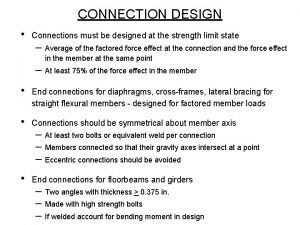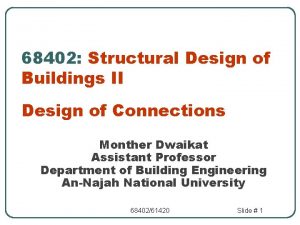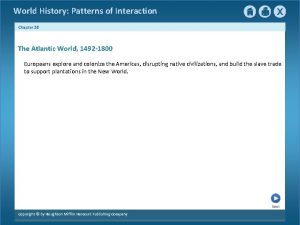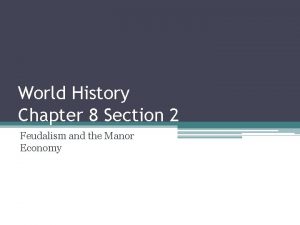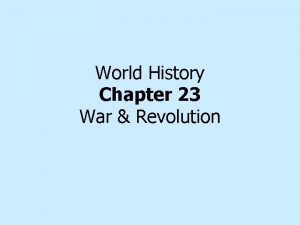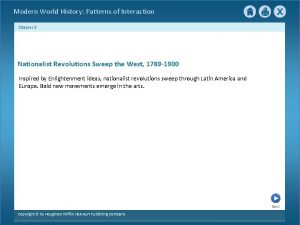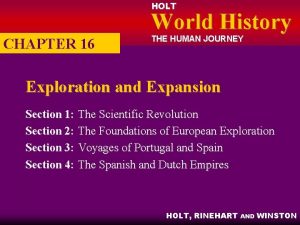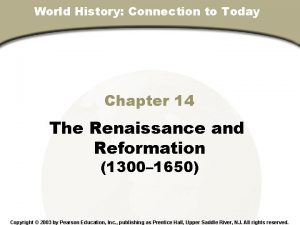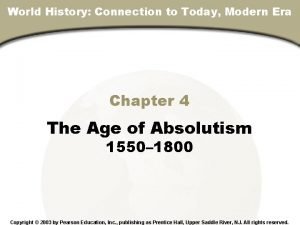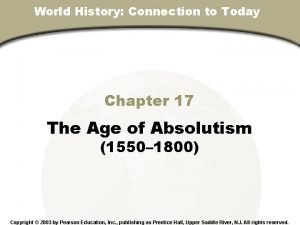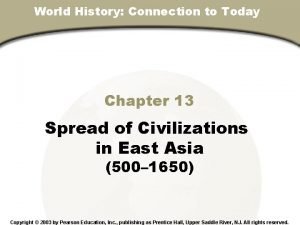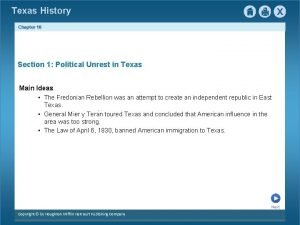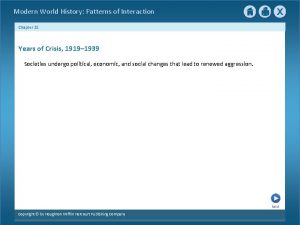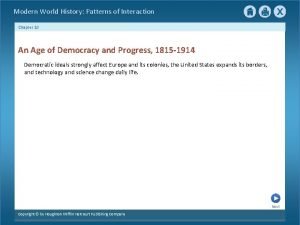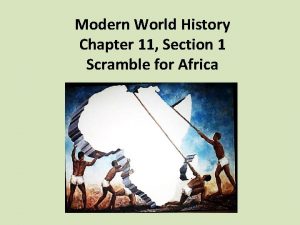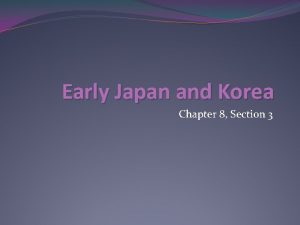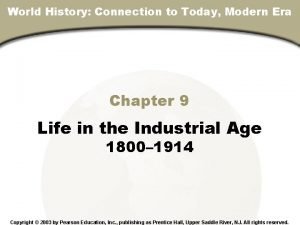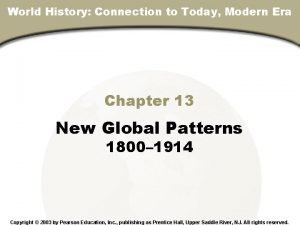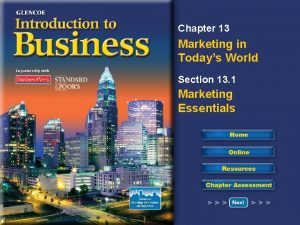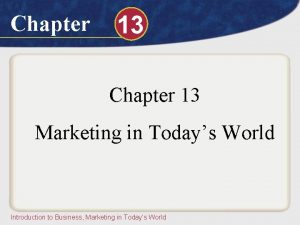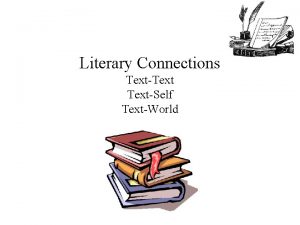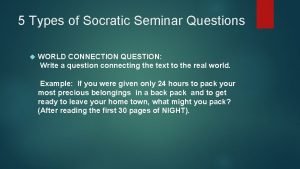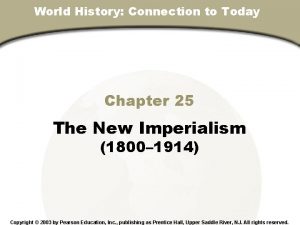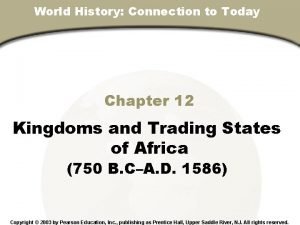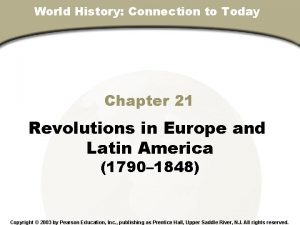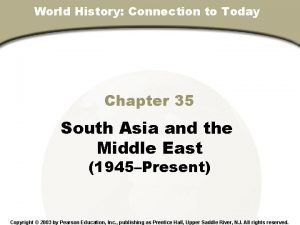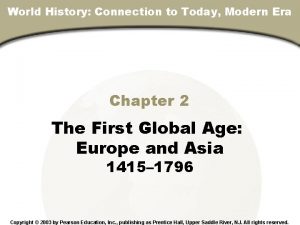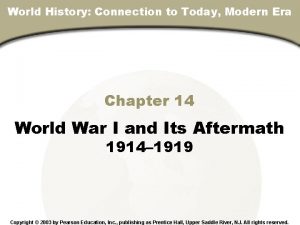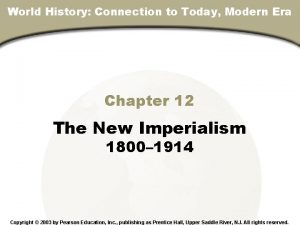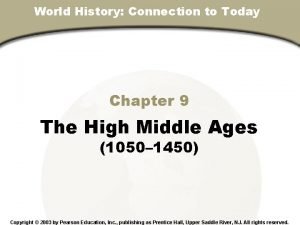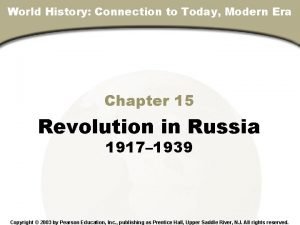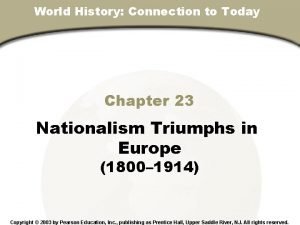World History Connection to Today Chapter 11 Section






































- Slides: 38

World History: Connection to Today Chapter 11, Section Chapter 11 The Muslim World (622– 1650) Copyright © 2003 by Pearson Education, Inc. , publishing as Prentice Hall, Upper Saddle River, NJ. All rights reserved.

World History: Connection to Today Chapter 11, Section Chapter 11: The Muslim World (622– 1650) Section 1: Rise of Islam Section 2: Islam Spreads Section 3: Golden Age of Muslim Civilization Section 4: Muslims in India Section 5: The Ottoman and Safavid Empires Copyright © 2003 by Pearson Education, Inc. , publishing as Prentice Hall, Upper Saddle River, NJ. All rights reserved.

Chapter 11, Section 1 Rise of Islam • How did Muhammad become the prophet of Islam? • What are the teachings of Islam? • How did Islam help shape the way of life of its believers?

Chapter 11, Section 1 Muhammad Became the Prophet of Islam Muhammad said he heard the angel Gabriel calling him to be the messenger of God. Muhammad devoted his life to spreading Islam. Muhammad made a journey from Mecca to Medina, where he was welcomed by Muslim converts. This was a turning point for Islam. Muhammad returned to Mecca and worked to unite Arabs under Islam.

Chapter 11, Section 1 The Teachings of Islam arose in the Arabian Peninsula and became one of the world’s major religions. Islam is monotheistic, based on the belief in one God. Muslims believe that the Quran contains the sacred word of God and is the final authority on all matters. All Muslims accept five duties, known as the Five Pillars of Islam: • faith • daily prayer • charity • fasting during Ramadan • hajj, or pilgrimage to Mecca

Chapter 11, Section 1 Islam as a Way of Life The Islamic system of law, called Sharia, regulated moral conduct, family life, business practices, government, and other aspects of a Muslim community. Unlike the law codes that evolved in the West, the Sharia does not separate religious matters from criminal or civil law.

Chapter 11, Section 1 Assessment The Five Pillars of Islam include all of the following except a) daily prayer. b) charity. c) belief in many gods. d) fasting during Ramadan. The Muslim law system, Sharia, a) only governs criminal law. b) only governs civil law. c) only governs religious law. d) governs all aspects of Muslim life. Want to connect to the World History link for this section? Click Here.

Chapter 11, Section 1 Assessment The Five Pillars of Islam include all of the following except a) daily prayer. b) charity. c) belief in many gods. d) fasting during Ramadan. The Muslim law system, Sharia, a) only governs criminal law. b) only governs civil law. c) only governs religious law. d) governs all aspects of Muslim life. Want to connect to the World History link for this section? Click Here.

Chapter 11, Section 2 Islam Spreads • How did Muslims conquer many lands? • What movements emerged within Islam? • Why did the empire of the caliphs decline?

Chapter 11, Section 2 An Age of Conquests

Chapter 11, Section 2 How were the Muslims able to conquer so many lands? The Byzantine and Persian empires were weak from years of fighting each other. People in the Fertile Crescent welcomed Arab conquerors as liberators. The Arabs used bold, efficient fighting methods, which overwhelmed traditional armies. The common faith of Islam united a patchwork of tribes into a determined, unified state.

Chapter 11, Section 2 Spread of Islam: Causes and Effects Immediate Effects Long-Term Effects Islam spreads from the Atlantic coast to the Indus Valley Muslim civilization emerges Centers of learning flourish in Cairo, Córdoba, and elsewhere Linking of Europe, Asia, and Africa through Muslim trade network Arabic becomes shared language of Muslims Split between Sunni and Shiites

Chapter 11, Section 2 Movements Within Islam Shortly after Muhammad’s death, divisions arose within Islam. SUNNI Believed caliph, or successor to Muhammad, should be chosen by leaders of the Muslim community. Viewed caliph as a leader, not as a religious authority. SHIITES Believed that only descendents of Muhammad could become caliph. Believed descendents of Muhammad to be divinely inspired. SUFI Sought to communicate with God through meditation, fasting, and other rituals.

Chapter 11, Section 2 The Umayyads and the Abbassids These powerful caliphates ruled the Islamic world, expanded the Arab empire, and brought about a golden age in Muslim civilization. UMAYYADS ABBASSIDS Set up dynasty that ruled until 750 Overthrew the Umayyads in 750 Conquered lands from Atlantic to the Indus Valley Ended Arab dominance and helped make Islam a universal religion Relied on local officials to govern the empire Faced economic tensions between wealthy and poor Arabs Empire of the caliphs reached its greatest wealth and power Muslim civilization enjoyed a golden age

Chapter 11, Section 2 Decline of the Muslim Empire Despite the decline of the empire, Islam continued to link diverse people across an enormous area. • Around 850, the caliphs became unable to maintain centralized control, and the empire fragmented. • In the 900 s, Seljuk Turks invaded the Middle East and built a large empire in the Fertile Crescent. • In the 1200 s and 1300 s, Mongol invaders dominated the Middle East.

Chapter 11, Section 2 Assessment Which group believed that only descendents of Muhammad could become caliph? a) Sunni b) Shiites c) Umayyads d) Sufi Islam spread to all of the following except a) France. b) Spain. c) North Africa. d) Persia. Want to connect to the World History link for this section? Click Here.

Chapter 11, Section 2 Assessment Which group believed that only descendents of Muhammad could become caliph? a) Sunni b) Shiites c) Umayyads d) Sufi Islam spread to all of the following except a) France. b) Spain. c) North Africa. d) Persia. Want to connect to the World History link for this section? Click Here.

Chapter 11, Section 3 Golden Age of Muslim Civilization • How were the Muslim society and economy organized? • What traditions influenced Muslim art and literature? • What advances did Muslims make in centers of learning?

Chapter 11, Section 3 Muslim Society Muslim rulers united people from diverse cultures. As a result, Muslim civilization absorbed and blended many traditions. The class distinction between Arabs and non-Arabs faded over time. People enjoyed a certain degree of social mobility, the ability to move up in social class. Slavery was a common institution.

Chapter 11, Section 3 The Muslim Economy Between 750 and 1360, merchants built a vast trading network across the Muslim world and beyond. New business practices were established, such as partnerships, credit, banks, and bank checks. Handicraft manufacturing in cities was organized by guilds. Outside the cities, agriculture flourished.

Chapter 11, Section 3 Influences on Art and Literature Islamic religion Traditions of the many people living under Muslim rule MUSLIM ART AND LITERATURE Skills and styles of Greeks, Romans, Persians, Indians, and other peoples with whom they came in contact

Chapter 11, Section 3 Muslim Advances in Learning ASTRONOMY MEDICINE Scholars studied Indian and Greek mathematics. Al-Khwarizmi developed astronomical tables. Government set up hospitals with emergency rooms. Al-Khwarizmi pioneered the study of algebra and wrote mathematics textbook that became standard in Europe. Astronomers calculated circumference of the Earth. Muhammad al-Razi studied measles and smallpox. PHILOSOPHY MATHEMATICS Scholars tried to harmonize Greek ideas of reason with religious teachings of Islam. Ibn Khaldun set standards for scientific study of history. Ibn Sina wrote a medical encyclopedia. Surgeons developed treatment for cataracts.

Chapter 11, Section 3 Assessment Which of the following was true of Muslim society throughout its golden age? a) Slavery was prohibited. b) Arabs and non-Arabs occupied distinct social classes. c) Muslim civilization blended and absorbed many traditions. d) There was very little social mobility. Which of the following was an achievement of Muslim surgeons? a) the treatment of cataracts b) a cure for smallpox c) immunizations for measles d) open-heart surgery Want to connect to the World History link for this section? Click Here.

Chapter 11, Section 3 Assessment Which of the following was true of Muslim society throughout its golden age? a) Slavery was prohibited. b) Arabs and non-Arabs occupied distinct social classes. c) Muslim civilization blended and absorbed many traditions. d) There was very little social mobility. Which of the following was an achievement of Muslim surgeons? a) the treatment of cataracts b) a cure for smallpox c) immunizations for measles d) open-heart surgery Want to connect to the World History link for this section? Click Here.

Chapter 11, Section 4 Muslims in India • What impact did the Delhi sultanate have on India? • How did Muslim and Hindu traditions clash and blend? • How did Akbar strengthen Mughal India?

Chapter 11, Section 4 The Delhi Sultanate and Mughal Empire

Chapter 11, Section 4 The Delhi Sultanate In the 1100 s, Muslim invaders entered northern India and organized a sultanate, or land ruled by a sultan. • Sultans introduced Muslim traditions of government to India. • Many Turks, Persians, and Arabs migrated to India to serve as soldiers or officials. • Trade between India and the Muslim world increased. • During the Mongol raids, many scholars fled from Baghdad to India, bringing Persian and Greek learning.

Chapter 11, Section 4 Hinduism and Islam Clash and Blend

Chapter 11, Section 4 Akbar the Great During his long reign, Akbar strengthened Mughal India. Akbar accomplished the following: • • • Implemented policy of religious toleration Employed paid officials, instead of hereditary officeholders Modernized the army Encouraged international trade Standardized weights and measures Introduced land reforms

Chapter 11, Section 4 Assessment Which of the following is true of Sikhism? a) Sikhs rejected the caste system. b) Sikhs supported the caste system. c) Sikhs saw priests as part of the caste system. d) Sikhs did not believe in reincarnation. What was Akbar the Great’s policy toward the many religions practiced in his empire? a) He persecuted non-Muslims. b) He practiced religious toleration. c) He banned all religions. d) He converted to Hinduism. Want to connect to the World History link for this section? Click Here.

Chapter 11, Section 4 Assessment Which of the following is true of Sikhism? a) Sikhs rejected the caste system. b) Sikhs supported the caste system. c) Sikhs saw priests as part of the caste system. d) Sikhs did not believe in reincarnation. What was Akbar the Great’s policy toward the many religions practiced in his empire? a) He persecuted non-Muslims. b) He practiced religious toleration. c) He banned all religions. d) He converted to Hinduism. Want to connect to the World History link for this section? Click Here.

Chapter 11, Section 5 The Ottoman and Safavid Empires • How did the Ottoman empire expand? • What were the characteristics of Ottoman culture? • How did Abbas the Great strengthen the Safavid empire?

Chapter 11, Section 5 “Gunpowder Empires” While the Mughals ruled India, the Ottomans and the Safavids dominated the Middle East and parts of Eastern Europe. All three owed much of their success to new military technology, such as cannons and muskets. As a result, the period from about 1450 to 1650 is sometimes called “the age of gunpowder empires. ”

Chapter 11, Section 5 Ottoman and Safavid Empires, 1453– 1629

Chapter 11, Section 5 The Ottoman Empire Under Suleiman GOVERNMENT Suleiman had absolute power. Ottoman law was based on Sharia. The Ottomans recruited government and military officers from conquered people. SOCIETY ARTS Society was divided into four classes, with “men of the pen” and “men of the sword” at the top. Poets produced works in the Turkish language. Non-Muslims were organized into millets, or religious communities. Painters produced detailed miniatures and illuminated manuscripts. The royal architect Sinan designed magnificent mosques and palaces.

Chapter 11, Section 5 Abbas the Great The most outstanding Safavid shah, or king, Abbas the Great revived the glory of ancient Persia. During his reign, he • • centralized government created a powerful military force strengthened the economy tolerated non-Muslims and valued their economic contributions used a mixture of force and diplomacy against the Ottomans forged alliances with European states built a magnificent new capital at Isfahan supported the growth of Persian culture

Chapter 11, Section 5 Assessment Which of the following lands became part of the Ottoman empire? a) Persia b) Austria c) Italy d) Asia Minor Which of the following describes a policy or achievement of Abbas the Great? a) He reduced the size of the military. b) He valued the economic contributions of non-Muslims. c) He built a new capital at Constantinople. d) He tried to conquer European states. Want to connect to the World History link for this section? Click Here.

Chapter 11, Section 5 Assessment Which of the following lands became part of the Ottoman empire? a) Persia b) Austria c) Italy d) Asia Minor Which of the following describes a policy or achievement of Abbas the Great? a) He reduced the size of the military. b) He valued the economic contributions of non-Muslims. c) He built a new capital at Constantinople. d) He tried to conquer European states. Want to connect to the World History link for this section? Click Here.
 Bolted connection
Bolted connection Shear plane in bolted connection
Shear plane in bolted connection Minimum fillet weld size
Minimum fillet weld size Text to self examples
Text to self examples Ap world history chapter 25 africa and the atlantic world
Ap world history chapter 25 africa and the atlantic world Chapter 17 section 3 world history
Chapter 17 section 3 world history Chapter 30 section 2 world history
Chapter 30 section 2 world history Chapter 15 section 1 world history
Chapter 15 section 1 world history World history chapter 15 section 3
World history chapter 15 section 3 World history patterns of interaction
World history patterns of interaction World history chapter 8 section 1
World history chapter 8 section 1 Chapter 23 section 3 world history
Chapter 23 section 3 world history Chapter 8 section 1 world history
Chapter 8 section 1 world history Chapter 16 section 1 world history
Chapter 16 section 1 world history Chapter 14 section 1 world history
Chapter 14 section 1 world history Chapter 4 section 4 world history
Chapter 4 section 4 world history Chapter 17 section 2 world history
Chapter 17 section 2 world history World history chapter 13 section 1
World history chapter 13 section 1 World history chapter 10 section 1
World history chapter 10 section 1 Chapter 15 section 2 world history
Chapter 15 section 2 world history Chapter 10 section 1 world history
Chapter 10 section 1 world history Chapter 11 the scramble for africa
Chapter 11 the scramble for africa Chapter 8 section 3 world history
Chapter 8 section 3 world history Chapter 9 section 2 world history
Chapter 9 section 2 world history Chapter 6 section 2 world history
Chapter 6 section 2 world history Chapter 13 section 2 world history
Chapter 13 section 2 world history Today meeting or today's meeting
Today meeting or today's meeting Today's class work
Today's class work Meeting objective
Meeting objective Fingerprint galton details
Fingerprint galton details Today's lesson or today lesson
Today's lesson or today lesson Example of repitition
Example of repitition Chapter 13 marketing in today's world
Chapter 13 marketing in today's world Chapter 13 marketing in today's world
Chapter 13 marketing in today's world Chapter 13 marketing in today's world
Chapter 13 marketing in today's world To make place decisions marketers select the right
To make place decisions marketers select the right Dangerous world tour setlist
Dangerous world tour setlist Literary connections examples
Literary connections examples Universal theme/core question
Universal theme/core question
